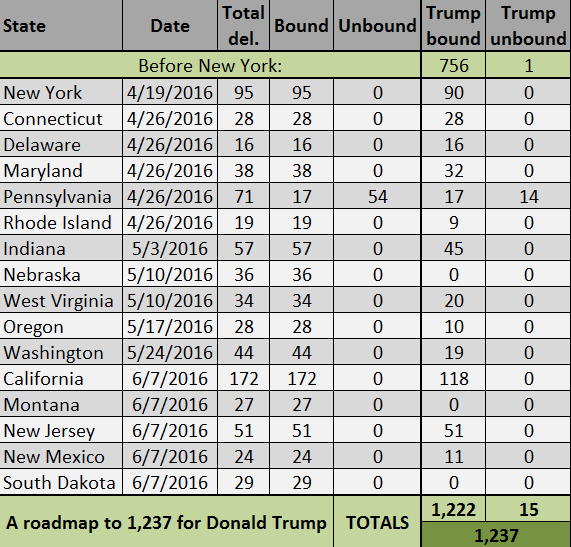Let’s get the easy part out of the way first. Bernie Sanders went into the New York Democratic primary with essentially no path to catching Hillary Clinton in the race for the Democratic presidential nomination, and he leaves it with even less of one after Clinton’s victory. Despite some national polls showing the race effectively a tie, Clinton has a lead in pledged delegates and superdelegates that Sanders cannot catch. Unless Clinton is somehow forced from the race, she will be the nominee. Sanders assuredly still has some victories to come, but the eventual outcome really is not in doubt.
Now, on to the Republicans, where the outcome remains very much in doubt.
Donald Trump did what he needed to do in New York on Tuesday night. He easily eclipsed 50% of the vote statewide and in most of the congressional districts, giving him 90 of the Empire State’s 95 delegates (as of Wednesday morning). His path to winning a delegate majority remains open, but it is perilous.
Table 1 provides a roadmap for how Trump could get to the 1,237 delegate mark. It is not a prediction of how he will perform — the potential pitfalls are many for him to accomplish the feat — but is meant to show there is at least some reasonable chance that he could still reach a delegate majority. But that’s far from a certainty. We did not overreact to Ted Cruz’s victory in Wisconsin and declare that a contested convention was all but certain, and we’re not going to overreact in the other direction after Trump’s strong New York victory.
Note: Colorado, North Dakota, Wyoming, and Guam are not included in the table even though they have some unbound delegates still pending. Trump could win support from a small number of delegates in those states and/or support from bound or unbound delegates who are officially uncommitted in other states and territories as well as delegates currently bound to former presidential candidates.
Source: Kyle Kondik and Geoffrey Skelley, centerforpolitics.org
 Listen Online
Listen Online Watch Online
Watch Online Find a Station in Your Area
Find a Station in Your Area









 Listen Now
Listen Now Watch Online
Watch Online
